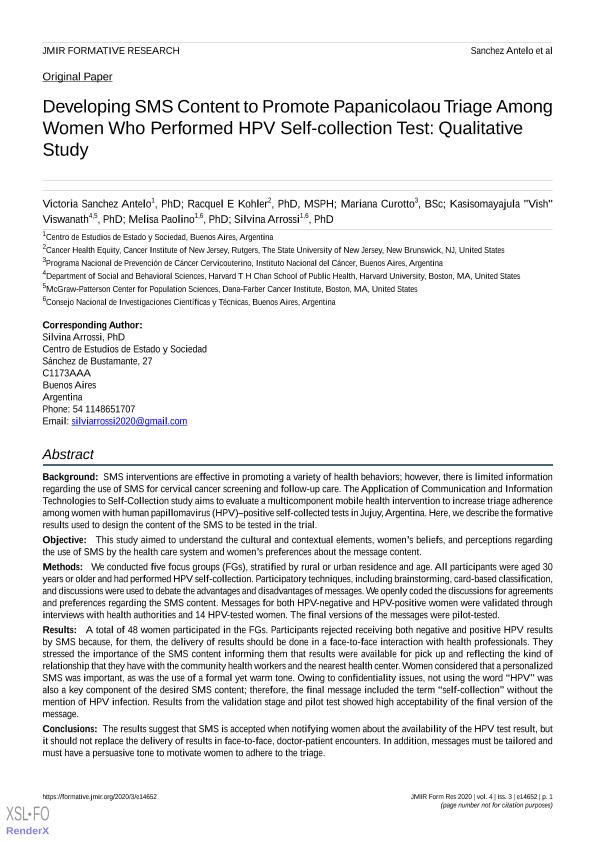Mostrar el registro sencillo del ítem
dc.contributor.author
Sánchez Antelo, Victoria Inés María

dc.contributor.author
Kohler, Racquel

dc.contributor.author
Ferraresi Curotto, Mariana

dc.contributor.author
Viswanath, Kasisomayajula Vish
dc.contributor.author
Paolino, Melisa Delia

dc.contributor.author
Arrossi, Silvina

dc.date.available
2022-09-13T14:10:57Z
dc.date.issued
2020-03
dc.identifier.citation
Sánchez Antelo, Victoria Inés María; Kohler, Racquel; Ferraresi Curotto, Mariana; Viswanath, Kasisomayajula Vish; Paolino, Melisa Delia; et al.; Developing SMS content to promote papanicolaou triage among women who performed HPV self-collection test: qualitative study; JMIR Publications Inc.; JMIR Formative Research; 4; 3; 3-2020; 1-14
dc.identifier.issn
2561-326X
dc.identifier.uri
http://hdl.handle.net/11336/168524
dc.description.abstract
Background: SMS interventions are effective in promoting a variety of health behaviors; however, there is limited information regarding the use of SMS for cervical cancer screening and follow-up care. The Application of Communication and Information Technologies to Self-Collection study aims to evaluate a multicomponent mobile health intervention to increase triage adherence among women with human papillomavirus (HPV)–positive self-collected tests in Jujuy, Argentina. Here, we describe the formative results used to design the content of the SMS to be tested in the trial. Objective: This study aimed to understand the cultural and contextual elements, women’s beliefs, and perceptions regarding the use of SMS by the health care system and women’s preferences about the message content. Methods: We conducted five focus groups (FGs), stratified by rural or urban residence and age. All participants were aged 30 years or older and had performed HPV self-collection. Participatory techniques, including brainstorming, card-based classification, and discussions were used to debate the advantages and disadvantages of messages. We openly coded the discussions for agreements and preferences regarding the SMS content. Messages for both HPV-negative and HPV-positive women were validated through interviews with health authorities and 14 HPV-tested women. The final versions of the messages were pilot-tested. Results: A total of 48 women participated in the FGs. Participants rejected receiving both negative and positive HPV results by SMS because, for them, the delivery of results should be done in a face-to-face interaction with health professionals. They stressed the importance of the SMS content informing them that results were available for pick up and reflecting the kind of relationship that they have with the community health workers and the nearest health center. Women considered that a personalized SMS was important, as was the use of a formal yet warm tone. Owing to confidentiality issues, not using the word “HPV” was also a key component of the desired SMS content; therefore, the final message included the term “self-collection” without the mention of HPV infection. Results from the validation stage and pilot test showed high acceptability of the final version of the message. Conclusions: The results suggest that SMS is accepted when notifying women about the availability of the HPV test result, but it should not replace the delivery of results in face-to-face, doctor-patient encounters. In addition, messages must be tailored and must have a persuasive tone to motivate women to adhere to the triage.
dc.format
application/pdf
dc.language.iso
eng
dc.publisher
JMIR Publications Inc.
dc.rights
info:eu-repo/semantics/openAccess
dc.rights.uri
https://creativecommons.org/licenses/by/2.5/ar/
dc.subject
ARGENTINA
dc.subject
CELL PHONE USE
dc.subject
HEALTH BEHAVIOR
dc.subject
HUMAN PAPILLOMAVIRUS DNA TESTS
dc.subject
TELEMEDICINE
dc.subject
TEXT MESSAGING
dc.subject
TRIAGE
dc.subject.classification
Otras Sociología

dc.subject.classification
Sociología

dc.subject.classification
CIENCIAS SOCIALES

dc.title
Developing SMS content to promote papanicolaou triage among women who performed HPV self-collection test: qualitative study
dc.type
info:eu-repo/semantics/article
dc.type
info:ar-repo/semantics/artículo
dc.type
info:eu-repo/semantics/publishedVersion
dc.date.updated
2022-09-12T14:18:50Z
dc.identifier.eissn
2561-326X
dc.journal.volume
4
dc.journal.number
3
dc.journal.pagination
1-14
dc.journal.pais
Canadá

dc.description.fil
Fil: Sánchez Antelo, Victoria Inés María. Centro de Estudios de Estado y Sociedad; Argentina. Consejo Nacional de Investigaciones Científicas y Técnicas; Argentina
dc.description.fil
Fil: Kohler, Racquel. State University of New Jersey; Estados Unidos
dc.description.fil
Fil: Ferraresi Curotto, Mariana. Ministerio de Salud. Instituto Nacional del Cáncer; Argentina
dc.description.fil
Fil: Viswanath, Kasisomayajula Vish. Dana Farber Cancer Institute; Estados Unidos. Harvard University. Harvard School of Public Health; Estados Unidos
dc.description.fil
Fil: Paolino, Melisa Delia. Centro de Estudios de Estado y Sociedad; Argentina. Consejo Nacional de Investigaciones Científicas y Técnicas; Argentina
dc.description.fil
Fil: Arrossi, Silvina. Centro de Estudios de Estado y Sociedad; Argentina. Consejo Nacional de Investigaciones Científicas y Técnicas; Argentina
dc.journal.title
JMIR Formative Research
dc.relation.alternativeid
info:eu-repo/semantics/altIdentifier/url/https://formative.jmir.org/2020/3/e14652
dc.relation.alternativeid
info:eu-repo/semantics/altIdentifier/doi/http://dx.doi.org/10.2196/14652
dc.relation.alternativeid
info:eu-repo/semantics/altIdentifier/url/https://www.ncbi.nlm.nih.gov/pmc/articles/PMC7084289/
Archivos asociados
